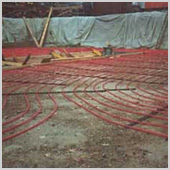
|
Heat Pumps
Ground Source Heat
At depths of more than 2m, the ground has a relatively constant temperature of 10°C
all year round. By embedding pipework in the ground, this temperature potential
can be used for heating during the winter, as well as for cooling during the summer.
There are two options for using ground-source heat: horizontal probes (see picture)
or vertical probes. Vertical probes are inserted into boreholes that are drilled
to depths of 40-150m (depending on the local geology). The ground heat is extracted from
the immediate surroundings of the probe with a circulating transfer fluid
(usually a water/anti-freeze mix). A heat pump is required for turning the low-grade heat
to high-grade heat sufficient for heating buildings.
Heat pumps are not in themselves an energy-saving technology. Overall energy savings
are only achieved
if the performance of the heat pump more than makes up for the heat losses that are
necessarily incurred in electricity generation from fossil fuels.
In order to achieve energy savings from heat pump systems, many factors have to be considered,
such as the required output temperature, the best energy sources for powering
the heat pump, the available sources of heat (e.g. ground
or water), soil type (in the case of ground-source heat), required permissions for heat extraction, compatibility with
existing heating installations, pressure
losses in pipework, length of the heating season, level of RHI support etc. Without
excellent understanding of these factors, a heat pump system will not provide
the expected performance.
Related Case Studies
|


